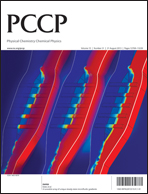The effect of secondary structures on the NLO properties of single chain oligopeptides: a comparison between β-strand and α-helix polyglycines†
Abstract
The evolution of the electronic first-order longitudinal hyperpolarizability (βzzz) and the hyperpolarizability aligned along the direction of the dipole moment (βμ) of the α-helix and β-strand single chain H2N–(CH2–CO–NH)n–CH2–COOH (n = 1–9) oligoglycines, were investigated. For this purpose we have used Hartree–Fock, second-order Møller–Plesset perturbation theory and Coulomb-attenuating Density Functional Theory computations. For the longest chain, βμ(β-strand) is one order of magnitude greater than βμ(α-helix), due to the cooperative effect of the α-helices being unfavourable for the NLO properties. The βzzz and βμ values per unit cell of the β-strand conformation were determined, extrapolating the properties in the limit of the


 Please wait while we load your content...
Please wait while we load your content...